Plants of the Gila Wilderness
Presented in Association with the
Western New Mexico University Department
of Natural Sciences
Heppia lutosa (Ach.) Nyl.
Soil Ruby Lichen
Heppia lutosa is a small squamulose lichen that grows in 1cm diameter rosettes on seasonally moist soil. The most notable
characteristic is the presence of orange to red apothecia that take up nearly the entirety of each squamule. Cross sections
are difficult by virtue of a gelatinous consistency to the thallus, but when carefully done there is no obvious lower cortex. The
photobiont is scytonema, a cyanobacterium found in chains when not lichenized, and in single large
cells when part of the lichen thallus. Filamentous forms can be seen at the edge just outside the thallus. There are 8 large elliptic
ascospores per ascus. We found Heppia lutosa in a shallow depression in bedrock growing on a thin layer of soil.
Please click on an image for a larger file.
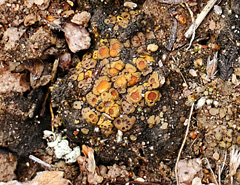
Heppia lutosa, photo Russ Kleinman & Karen Blisard, Gila NF, Ben Lily, March 10, 2020
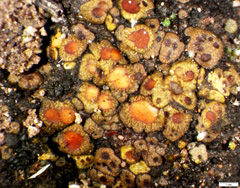
Heppia lutosa, closeup of rosette, photo Russ Kleinman & Karen Blisard, Gila NF, Ben Lily, March 10, 2020
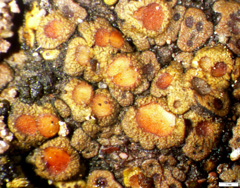
Heppia lutosa, closeup of squamules and apothecia, photo Russ Kleinman & Karen Blisard, Gila NF, Ben Lily, March 10, 2020
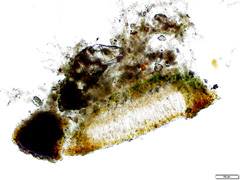
Heppia lutosa, photomicrograph of squamule with apothecium, photo Russ Kleinman & Karen Blisard, Gila NF, Ben Lily, March 10, 2020
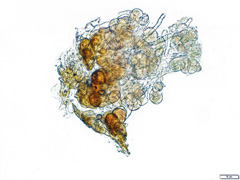
Heppia lutosa, photomicrograph of lichenized Scytonema, photo Russ Kleinman & Karen Blisard, Gila NF, Ben Lily, March 10, 2020
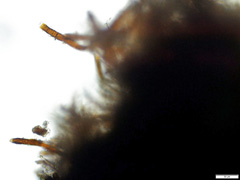
Heppia lutosa, photomicrograph of filamentous Scytonema at thallus margin, photo Russ Kleinman & Karen Blisard, Gila NF, Ben Lily, March 10, 2020
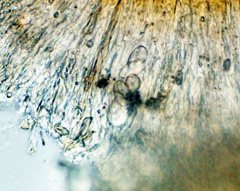
Heppia lutosa, photomicrograph of 8 large elliptic ascospores in ascus, photo Russ Kleinman & Karen Blisard, Gila NF, Ben Lily, March 10, 2020
Back to the Index






